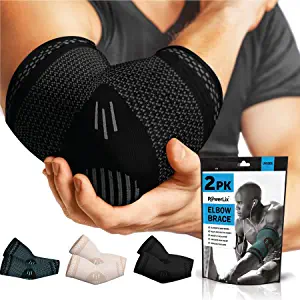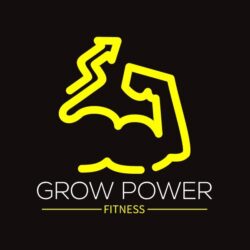Tennis elbow, also known as lateral epicondylitis, is a common condition that affects the tendons in the elbow. It is characterized by pain and inflammation on the outer side of the elbow, often radiating down the forearm. Despite its name, tennis elbow can occur in individuals who engage in various repetitive arm motions, not just tennis players. In this article, we will delve into the causes, symptoms, diagnosis, treatment options, prevention techniques, and recovery strategies for this condition.
Introduction
Tennis elbow is an overuse injury that occurs when the tendons in the elbow are strained due to repetitive motion or excessive stress. The condition commonly affects the dominant arm but can also develop in the non-dominant arm or both arms simultaneously. While tennis players are more prone to this condition, it can also affect individuals who engage in activities such as golf, weightlifting, painting, typing, or any other repetitive arm movement.

Bodyprox Elbow Brace 2 Pack for Tennis & Golfer’s Elbow Pain Relief
Causes of Tennis Elbow
Tennis elbow is primarily caused by repetitive stress on the tendons and muscles in the forearm that are attached to the lateral epicondyle, a bony prominence on the outer side of the elbow. The repeated motions cause microscopic tears in the tendons, leading to inflammation and pain. Some common causes of this condition include:
- Sports Activities: Repetitive arm motions involved in sports like tennis, golf, squash, or racquetball can strain the tendons and lead to tennis elbow.
- Occupational Factors: Jobs that require repetitive gripping, lifting, or twisting motions, such as plumbing, painting, carpentry, or typing, can contribute to the development of tennis elbow.
- Improper Technique: Using incorrect form or technique while performing certain activities can put excessive stress on the tendons and increase the risk of tennis elbow.
- Age and Gender: Tennis elbow is more common in individuals between the ages of 30 and 50. It also tends to affect men and women equally.
Symptoms
The most common symptom of tennis elbow is pain and tenderness on the outer side of the elbow. The pain may gradually worsen over time and can be felt during activities that involve gripping or lifting, as well as when performing simple tasks like shaking hands or turning a doorknob. Other symptoms may include:
- Weak Grip Strength: Individuals with tennis elbow may experience a weakened grip, making it difficult to hold objects or perform tasks that require a firm grasp.
- Stiffness: Stiffness in the elbow joint and forearm muscles may be experienced, especially in the morning or after periods of rest.
- Radiating Pain: The pain may radiate down the forearm, and in some cases, individuals may also experience pain in the upper arm or wrist.
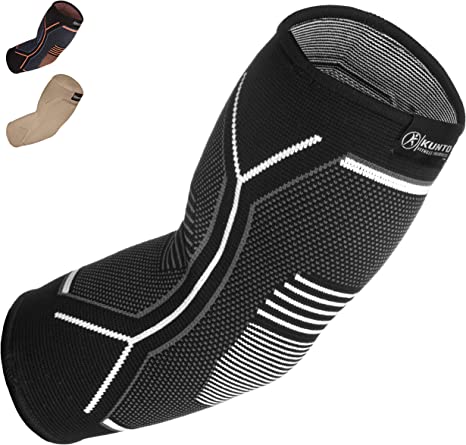
Kunto Fitness Elbow Brace Compression Support Sleeve (Shipped From USA) for Tendonitis, Tennis Elbow, Golf Elbow Treatment – Reduce Joint Pain During Any Activity!
Diagnosing
If you suspect you have tennis elbow, it is important to consult a healthcare professional for an accurate diagnosis. The diagnosis of tennis elbow typically involves:
- Medical History and Physical Examination: The doctor will discuss your symptoms and medical history, as well as perform a physical examination to assess the range of motion, tenderness, and strength of the affected arm.
- Diagnostic Tests: While imaging tests like X-rays or MRI scans are not always necessary, they may be ordered to rule out other conditions and confirm the diagnosis of tennis elbow.
Treatment Options
The treatment of tennis elbow aims to relieve pain, reduce inflammation, promote healing, and restore function. The following treatment options are commonly used:
Rest and Activity Modification:
Giving the affected arm adequate rest and avoiding activities that worsen the symptoms can help reduce pain and allow the tendons to heal. It is important to modify activities that involve repetitive arm motions or gripping to prevent further strain.
Physical Therapy:
A physical therapist can provide exercises and techniques to strengthen the muscles and tendons around the elbow, improve flexibility, and promote healing. They may also use techniques such as ultrasound, massage, or electrical stimulation to aid in the recovery process.
Medications:
Over-the-counter nonsteroidal anti-inflammatory drugs (NSAIDs), such as ibuprofen, can help reduce pain and inflammation associated with tennis elbow. In some cases, your healthcare provider may prescribe stronger pain medications or topical creams to provide relief.
Bracing:
Wearing a brace or forearm strap can help alleviate pressure on the injured tendons, provide support, and reduce pain during activities. These braces are usually worn during sports or work-related tasks.
Corticosteroid Injections:
In severe cases where conservative treatments have not provided sufficient relief, your healthcare provider may recommend a corticosteroid injection. This powerful anti-inflammatory medication is injected directly into the affected area to reduce inflammation and relieve pain. However, it’s important to note that repeated corticosteroid injections may weaken the tendon over time.
Platelet-Rich Plasma (PRP) Therapy:
This emerging treatment involves injecting a concentrated solution of platelets from your own blood into the affected area. Platelets contain growth factors that can aid in the healing process and promote tissue regeneration.
- Surgery: In rare cases where all other treatments have failed, surgery may be considered. Surgical options include removing damaged tissue, repairing or releasing the affected tendons, or in some cases, reattaching the tendon to the bone. Surgery is usually a last resort and is followed by a period of rehabilitation and physical therapy.
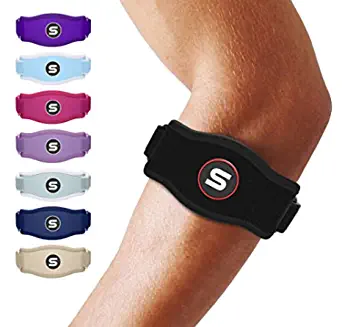
Sleeve Stars Tennis Elbow Brace for Women & Men, Tennis Elbow Strap Tendonitis Arm Band, Counterforce Brace & Elbow Band for Tendon Pain Relief w/ 3 Forearm Support Straps, Fits 9-23″ (Single/Black)
Prevention
Prevention is key when it comes to tennis elbow. Here are some preventive measures you can take:
- Proper Technique and Equipment: Whether you’re playing sports or performing daily activities, it’s important to use proper technique and equipment. Seek guidance from a professional to ensure you are using the correct form and technique to minimize strain on the tendons. Using equipment with the right grip size and ergonomic design can also help reduce the risk of developing tennis elbow.
- Strengthening Exercises: Regularly incorporating exercises that target the forearm muscles can help strengthen them, making them more resistant to injury. Consult with a physical therapist or fitness professional for a tailored exercise program.
- Gradual Increase in Intensity: If you’re starting a new activity or exercise regimen, gradually increase the intensity and duration to allow your muscles and tendons to adapt. Sudden or excessive changes in activity levels can put stress on the tendons and increase the risk of injury.
- Proper Warm-up and Stretching: Before engaging in any physical activity, warm up your muscles with light aerobic exercises and perform dynamic stretching to prepare your body for the demands of the activity. Afterward, engage in static stretches to improve flexibility and prevent muscle imbalances.
- Take Breaks and Listen to Your Body: Avoid overexertion and take frequent breaks during repetitive activities. Listen to your body and pay attention to any signs of pain or discomfort. If you experience persistent pain, modify your activities or seek medical attention to prevent further injury.
Recovery and Rehabilitation
Recovering from tennis elbow requires patience and adherence to a comprehensive rehabilitation program. Here are some key points to consider during the recovery process:
- Rest and Ice: Resting the affected arm and applying ice packs for 15-20 minutes several times a day can help reduce inflammation and alleviate pain. Avoid activities that aggravate the symptoms and allow the injured tendons to heal.
- Stretching and Strengthening Exercises: Gradually introduce gentle stretching exercises for the forearm muscles to improve flexibility and prevent stiffness. Strengthening exercises, such as wrist curls and forearm pronation/supination, can help rebuild strength in the affected area. It is important to work with a physical therapist or healthcare professional to ensure proper form and progression.
- Gradual Return to Activities: As symptoms improve, slowly reintroduce activities that were previously avoided. Start with low-impact exercises and gradually increase intensity and duration over time. Listen to your body and be mindful of any pain or discomfort. If symptoms persist or worsen, reduce activity levels and consult your healthcare provider.
- Pain Management Techniques: In addition to medication, there are various pain management techniques that can be beneficial during the recovery phase. These include heat therapy, massage, transcutaneous electrical nerve stimulation (TENS), and acupuncture. Consult with a healthcare professional to determine which techniques may be suitable for you.
- Supportive Devices: Depending on the severity of your condition, your healthcare provider may recommend the use of supportive devices such as braces, straps, or splints. These can help provide stability, relieve strain on the tendons, and facilitate the healing process. It is important to use these devices as instructed and gradually wean off them as your condition improves.
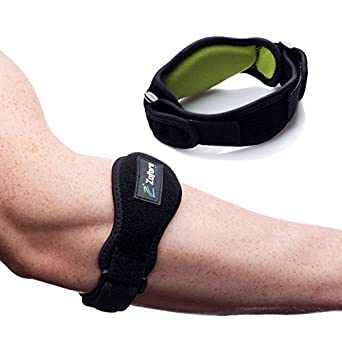
ZOFORE SPORT Tennis Elbow Brace With Compression Pad (2-Count) – Effective Pain Relief for Tennis & Golfer’s Elbow for Men & Women
Tennis Elbow vs. Golfer’s Elbow
Tennis elbow and golfer’s elbow (medial epicondylitis) are both common conditions that affect the elbow and forearm tendons. While they share similarities, there are distinct differences between the two:
- Affected Area: Tennis elbow affects the tendons on the outer side of the elbow, while golfer’s elbow affects the tendons on the inner side.
- Symptoms: Tennis elbow causes pain and tenderness on the outer side of the elbow that may radiate down the forearm. Golfer’s elbow, on the other hand, causes pain and tenderness on the inner side of the elbow, often radiating down the forearm.
- Causes: Tennis elbow is typically caused by repetitive motions and strains on the extensor tendons, whereas golfer’s elbow is caused by repetitive motions and strains on the flexor tendons.
- Treatment: Although the treatment approaches for both conditions are similar, there may be slight variations in the specific exercises and therapies based on the affected tendons.
If you are experiencing symptoms of either condition, it is important to consult a healthcare professional for an accurate diagnosis and appropriate treatment plan.
Coping with this condition
Coping with tennis elbow involves not only physical recovery but also addressing the emotional and practical challenges that may arise. Here are some strategies to help you cope with tennis elbow:
- Lifestyle Modifications: Modify your daily activities to avoid exacerbating the symptoms. This may involve adjusting your workstation ergonomics, using assistive devices for gripping tasks, or delegating certain activities to reduce strain on the affected arm.
- Pain Management Techniques: Utilize pain management techniques such as applying heat or cold therapy, practicing relaxation techniques, or using over-the-counter pain relievers as directed by your healthcare provider.
- Psychological Support: Seek support from friends, family, or support groups who can provide understanding and encouragement during your recovery journey. Additionally, consider consulting with a mental health professional who can help you navigate the emotional challenges associated with chronic pain and limitations.
- Patience and Persistence: Understand that recovery from tennis elbow takes time and dedication. Be patient with yourself and follow your healthcare provider’s recommendations and rehabilitation plan consistently.
- Maintain Overall Fitness: While your focus may be on rehabilitating your elbow joint, it is important to maintain overall fitness and strength. Engage in low-impact exercises that do not aggravate your symptoms, such as swimming or cycling. Strengthening other areas of your body, such as your core and lower body, can also help improve your overall physical condition and support your recovery.
Remember to consult with your healthcare provider or physical therapist before starting any new exercise regimen to ensure it is safe and appropriate for your specific condition.
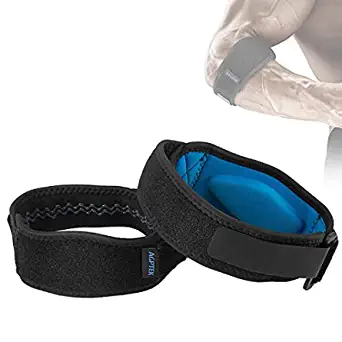
AGPTEK Elbow Brace for Tendonitis and Tennis Elbow 2 Pack, Tennis Golfers Elbow Support Arm Band Pain Relief Elbow Wrap Weightlifting Elbow Strap with Compression Pad for Men & Women
Common Myths and Misconceptions
There are several common myths and misconceptions surrounding tennis elbow. Let’s debunk some of them:
- Myth: Only tennis players get this condition. While the name suggests a connection to tennis, tennis elbow can affect anyone who engages in repetitive arm motions or activities that strain the tendons in the elbow. It is not exclusive to tennis players.
- Myth: Rest is the only treatment needed for tennis elbow. While rest is an important part of the recovery process, it is rarely the only treatment needed for this condition. A comprehensive treatment plan that includes rest, exercises, pain management techniques, and, in some cases, medical interventions, is typically necessary for effective healing.
- Myth: Surgery is always required for tennis elbow. Surgery is usually considered as a last resort when conservative treatments have failed to provide relief. Many cases of tennis elbow can be successfully managed with non-surgical approaches such as rest, physical therapy, medications, and lifestyle modifications.
It is important to seek professional medical advice and individualized treatment for your tennis elbow condition to ensure the most effective and appropriate care.
Conclusion
Tennis elbow is a common condition characterized by pain and inflammation in the tendons of the elbow. It can affect individuals involved in various activities, not just tennis players. By understanding the causes, symptoms, treatment options, prevention techniques, and recovery strategies discussed in this article, you can take proactive steps to manage and overcome this condition.
Remember to listen to your body, seek professional guidance, and be patient during your recovery journey. With proper care, rehabilitation, and prevention measures, you can alleviate pain, restore function, and minimize the risk of future recurrence.
FAQs
What causes tennis elbow?
Tennis elbow is primarily caused by repetitive arm motions or excessive strain on the tendons of the elbow. Activities like tennis, golf, typing, or repetitive lifting can contribute to its development.
How long does it take to recover from tennis elbow?
The recovery time for tennis elbow varies from person to person and depends on the severity of the condition, adherence to treatment, and individual factors. In general, mild cases may recover within a few weeks, while more severe cases may take several months.
Can tennis elbow be prevented?
While tennis elbow cannot be completely prevented, certain measures can reduce the risk. These include using proper technique and equipment, gradually increasing activity levels, and incorporating strengthening exercises for the forearm muscles.
Can physical therapy help with tennis elbow?
Yes, physical therapy is often a key component of tennis elbow treatment. It involves exercises to strengthen the affected muscles and tendons, improve flexibility, and aid in the recovery process.
Is surgery always necessary for tennis elbow?
No, surgery is typically considered only when conservative treatments have failed to provide relief. The majority of tennis elbow cases can be effectively managed with non-surgical approaches such as rest, exercises, and other therapies.
Thank you for taking the time to read this article on tennis elbow. We hope it has provided you with valuable information regarding the causes, symptoms, diagnosis, treatment options, prevention techniques, and recovery strategies associated with this condition. By understanding the nature of tennis elbow and implementing the recommended measures, you can effectively manage and overcome this common issue.
If you have any further questions or concerns, please consult with a healthcare professional who can provide personalized advice based on your specific situation. Remember, early diagnosis and appropriate treatment can significantly contribute to your recovery.
